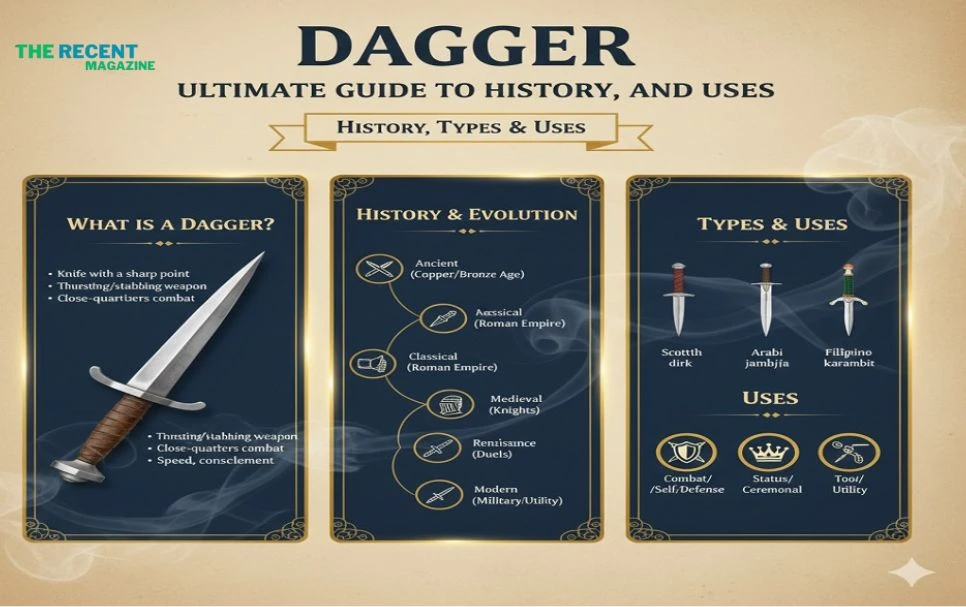Now Reading: Dagger: Ultimate Guide to History, Types, and Uses
-
01
Dagger: Ultimate Guide to History, Types, and Uses
Dagger: Ultimate Guide to History, Types, and Uses

When you hear the word “dagger,” what comes to your mind? Is it a sharp, deadly weapon from ancient times, a powerful symbol in stories, or maybe even a term used in basketball?
Whether you’re fascinated by its history, curious about its symbolic meanings, or want to understand how this small but mighty blade has influenced language and culture, this article is for you. You’ll discover the many faces of the dagger from its role as a fighting tool to its surprising place in modern slang.
Ready to dive into the world of the dagger and uncover its secrets? Keep reading, and you won’t look at this iconic weapon the same way again.
History Of Daggers
The originof daggers dates back to ancient times. Early humans used sharpened stones and bones as cutting tools. Over time, metal daggers made from bronze and iron became common. These weapons were small but deadly, used for close combatand as ceremonial objects.
During the medieval and Renaissanceperiods, daggers became more refined and decorative. Knights and nobles carried them for self-defenseand as status symbols. Many daggers had intricate designs, showing the owner’s wealth and rank. They were often used alongside swords in battle.
In modern times, daggers are mainly used for ceremonialor collectingpurposes. Some military units still carry daggers as part of their uniform. The design today focuses more on utility and precision rather than decoration.
Types Of Daggers
Double-edged daggershave sharp edges on both sides. They are great for cutting and thrusting. This design helps in fighting and self-defense. The blade is usually symmetricaland sharp at the tip.
Single-edged daggershave only one sharp side. The other side is usually flat or rounded. This type is easier to make and often used for cutting tasks. The blade can be curved or straight.
Decorative and ceremonial daggersare made for show, not battle. They often have ornate handlesand engraved blades. These daggers symbolize honor, power, or tradition. They are used in rituals or as gifts.
Design Features
Daggers have different blade shapes, such as straight, curved, or double-edged. The blades are made from steel, carbon steel, or stainless steel for strength and sharpness. Some blades have a mirror finish, while others have a matte look to reduce shine.
Handles come in many styles and materials. Common materials include wood, bone, metal, and synthetic plastics. Some handles have textured grips for better hold. Others are smooth for comfort and style.
Balance and weight matter for dagger use. A well-balanced dagger feels easy to controland not too heavy. The weight is usually centered near the blade or handle depending on its purpose.

Uses Of Daggers
Daggersare small, sharp knives used for combat and self-defense. Their pointed blades help in quick attacks and close fighting. People carry daggers for protection in dangerous situations. They are easy to hide and quick to use.
Daggers also hold symbolic and ceremonial roles. Many cultures use them in rituals and ceremonies. They represent power, courage, and honor. Some daggers are decorated with special designs to show status or tradition.
Collectors value daggers for their history and craftsmanship. Some daggers are old and rare, making them prized items. They can be displayed in homes or museums to show their beauty and story. Collecting daggers is a popular hobby for many people.
Legal Restrictions
Laws about daggersvary widely across countries and states. Some places bandaggers completely, while others allow ownership with limits. Restrictions often depend on the dagger’s blade lengthand how it is carried.
Reasons for prohibition include concerns about public safetyand crime prevention. Daggers are seen as dangerous weaponsdue to their sharp points and ease of concealment. Many governments want to reduce their use in violent acts.
Rules about carrying and owning daggers differ. Some areas require a permitor have age limits. Others forbid carrying daggers in public places. Ownership might be allowed only for collectorsor for historical purposes.
| Region | Ownership | Carrying | Notes |
|---|---|---|---|
| United States (varies by state) | Allowed with restrictions | Often banned in public | Some states require permits |
| United Kingdom | Mostly illegal | Carrying prohibited | Exceptions for antiques |
| Australia | Strictly controlled | Carrying banned | Varies by state |
| Germany | Allowed with limits | Carrying restricted | Blade length rules apply |
Daggers In Language And Culture
The word “dagger”appears in many slang and idioms. In basketball, a “dagger” is a decisive shotthat ends the game or breaks the opponent’s spirit. For example, a three-pointerin the last seconds that secures victory is called a “dagger.”
Other slang uses include “bull-dagger”, a term in the LGBTQ+ community for a masculine lesbian. The phrase “look daggers”means to stare angrilyat someone. “At daggers drawn”describes a state of open conflictbetween people.
Symbolically, a dagger often means dangeror harm. It can stand for something that wounds emotionally, like unfairness or betrayal.
| Term | Meaning |
|---|---|
| Dagger (Basketball) | A crucial shot that ends the game or silences the crowd |
| Bull-Dagger | Slang for a masculine or butch lesbian |
| Look Daggers | To stare angrily at someone |
| At Daggers Drawn | In a state of open conflict or hostility |
In sports, “dagger” shows a powerful, final move. In language, it often suggests anger, conflict, or hurt. This simple word carries strong, sharp meaningsin culture.
Famous Daggers
Historical daggersare prized artifacts from many cultures. The Krisfrom Southeast Asia is known for its wavy blade and mystical powers. The Roman pugiowas a soldier’s weapon, small but deadly. The Scottish dirkis famous for its role in clan battles and ceremonies.
Daggers often appear in literature and films. They symbolize danger, secrecy, or power. Shakespeare’s plays mention daggers as signs of guilt and fear. Movies use daggers for dramatic fight scenes or secret missions.
Modern daggers combine old styles with new materials. Some have titanium bladesfor strength and lightness. Others feature ergonomic handlesfor better grip. Collectors seek these for both use and display.
Maintenance And Care
Cleaning a dagger regularly keeps it in good condition. Use a soft cloth to wipe off dirt and moistureafter each use. Avoid soaking the blade in water as it can cause rust. For stubborn stains, use mild soap and dry the dagger immediately.
Sharpening should be done carefully with a fine whetstone. Hold the blade at a 20-degree angleand slide it smoothly along the stone. Repeat on both sides to keep the edge even. Sharpening frequently helps maintain a sharp and safe blade.
Store daggers in a dry placeaway from humidity. Use a sheath or blade guard to protect the edge and prevent accidents. Keep daggers separate from other tools to avoid damage. Regular checks for rust or wear help maintain longevity.
Frequently Asked Questions
What Does A Dagger Mean In Slang?
In slang, a “dagger” is a decisive basketball shot that ends the game or breaks the opponent’s spirit. It also means angry staring (“look daggers”) or refers to a masculine lesbian (“bull-dagger”).
Why Is It Illegal To Carry A Dagger?
Carrying a dagger is illegal because it poses a high risk as a concealed, easily accessible weapon. Laws aim to prevent violence and ensure public safety.
What Is A Dagger In Writing?
A dagger in writing is a symbol (†) used to indicate a footnote or denote death. It clarifies or adds information.
What Is A Dagger Vs Knife?
A dagger is a double-edged weapon designed for stabbing. A knife usually has one edge and serves general cutting purposes.
Conclusion
Daggers have a rich history as sharp, quick weapons. They symbolize both bravery and secrecy. In slang, “dagger” shows power in sports and strong feelings in speech. Understanding daggers helps us see their role in culture and language. Whether as tools or symbols, daggers remain striking and memorable.
Their impact goes beyond the blade itself. Our all updete get to visit our website: therecentmagazine.com























